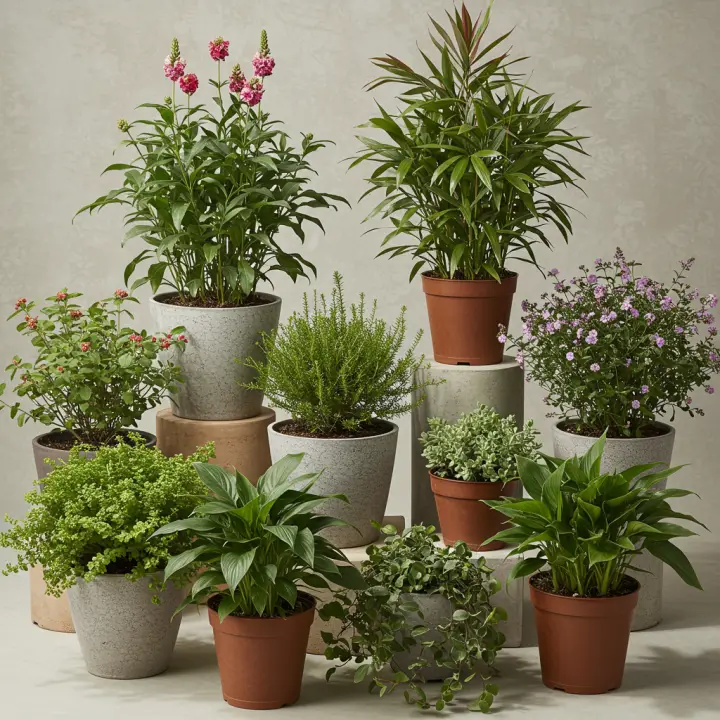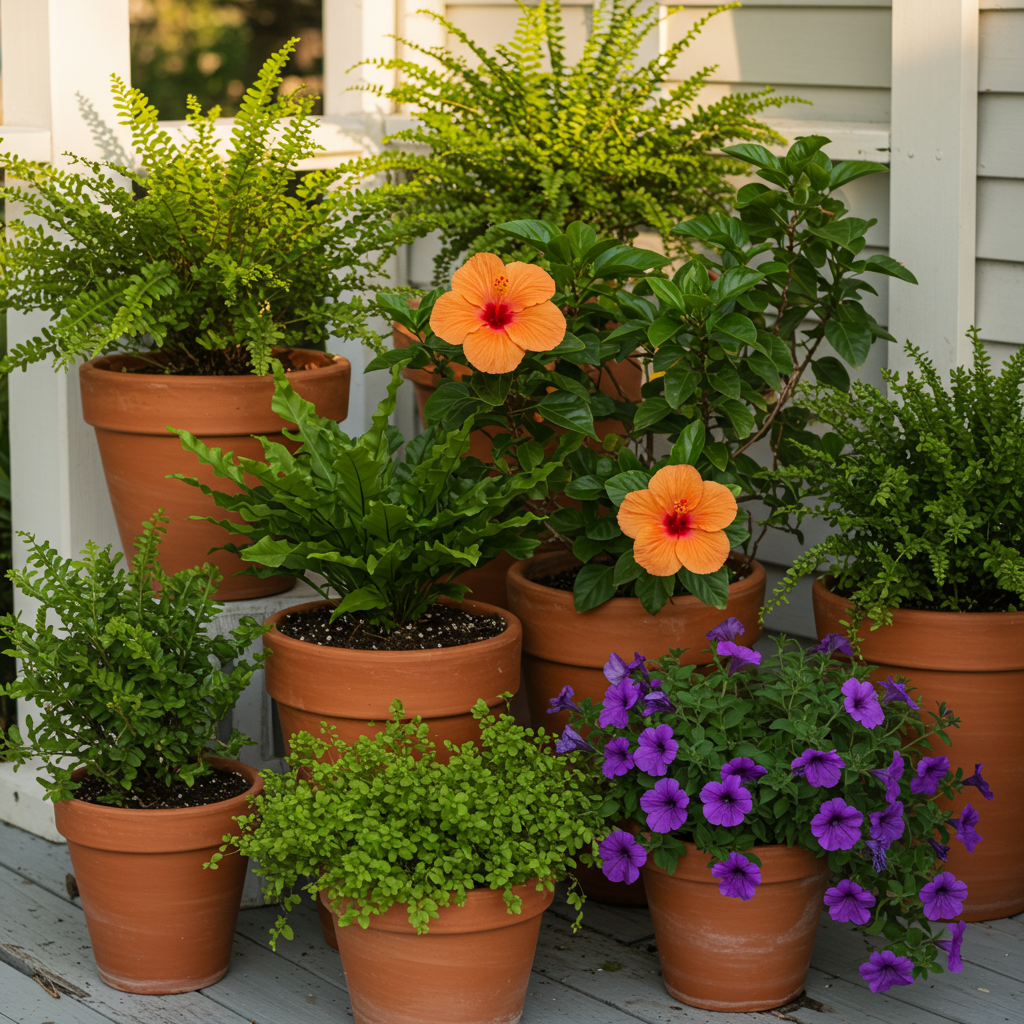Transform your patio, balcony, or lanai with the best Central Florida plants for potting. Discover vibrant, low-maintenance, and heat-loving options that thrive in our unique climate, from colorful flowers that bloom year-round to lush, dramatic foliage that creates a tropical oasis.
Container gardening in Central Florida is a fantastic way to add color, life, and personality to your outdoor spaces. It offers control over soil, makes it easy to protect plants from occasional frosts, and allows you to create curated designs on any surface. This guide will walk you through everything you need to know, from understanding our climate to choosing the perfect plants and caring for them like a pro.
—
Why Container Gardening is a Game-Changer in Central Florida

Living in Central Florida means enjoying a nearly year-round growing season, but it also comes with unique challenges: intense sun, high humidity, sandy soil, and sudden, heavy rainstorms. Potting your plants provides brilliant solutions to these common hurdles.
Ultimate Soil Control: Much of Florida’s native soil is sandy and low in nutrients. With containers, you can create the perfect soil mix for any plant, from succulents that need sharp drainage to tropical flowers that crave rich, organic matter.
Mobility and Protection: Central Florida isn’t immune to the occasional freeze. Potted plants can be easily moved indoors, into a garage, or to a sheltered spot to protect them from a cold snap. You can also move them to find the perfect amount of sun as the seasons change.
Pest and Disease Management: It’s much easier to spot and manage pests or diseases on a single potted plant than in a large garden bed. Isolation prevents problems from spreading quickly.
Instant Design Impact: Container gardening is perfect for renters, small-space dwellers, or anyone wanting to add a splash of color to a patio, pool deck, or front porch. You can create a lush garden without ever digging in the ground.
Understanding the Central Florida Climate: Your Key to Success
Before you start picking plants, it’s crucial to understand the environment they’ll be living in. Central Florida primarily falls into USDA Hardiness Zones 9a and 9b. This means our average minimum winter temperatures can dip between 20-30°F (-6.7 to -1.1°C), though this is often for very short periods.
The defining characteristics of our climate are:
Intense Sun and Heat: The summer sun is scorching. Plants need to be heat-tolerant and, in many cases, appreciate some relief from the harsh afternoon sun.
High Humidity: While some tropical plants love it, high humidity can promote fungal diseases if there isn’t good air circulation.
Distinct Wet and Dry Seasons: We have a rainy season in the summer, with near-daily downpours, and a much drier period through the fall, winter, and spring. Your watering habits must adapt accordingly.
Choosing plants that are naturally suited to these conditions is the number one secret to successful container gardening here.
Top Picks for Sun-Loving Potted Plants
These tough, beautiful plants thrive in the sunshine and heat that Central Florida is famous for. They are perfect for open patios, pool decks, and any area that receives at least 6-8 hours of direct sun per day.
Bougainvillea (Bougainvillea spp.)
Bougainvillea is the quintessential tropical bloomer. What appear to be vibrant paper-like petals are actually modified leaves called “bracts,” which surround the tiny white flowers. They come in stunning shades of magenta, purple, red, orange, white, and pink.
Why it’s Great for Pots: Bougainvillea loves to have its roots slightly constrained, which encourages more prolific blooming. Their vining nature makes them excellent for training up a small trellis within a large pot.
Potting Needs: Use a pot with excellent drainage. A terracotta pot is a good choice as it allows the soil to dry out between waterings, which this plant prefers. Use a potting mix amended with perlite or sand for sharpness.
Care Tips: Water deeply but infrequently, allowing the soil to become visibly dry before watering again. Bougainvillea blooms on new growth, so fertilize during the growing season but back off if you get all leaves and no bracts. They are drought-tolerant once established.
Hibiscus (Hibiscus rosa-sinensis)
With their huge, showy blossoms, Tropical Hibiscus plants scream Florida. The flowers, which can be as large as a dinner plate, come in a dazzling array of colors and last for a day or two, but the plant produces them continuously throughout the warm months.
Why it’s Great for Pots: Potting allows you to give this tropical beauty the rich soil and consistent moisture it craves. You can also easily move it to a protected location if a frost is predicted.
Potting Needs: Choose a large, stable container to support its size. Use a high-quality, well-draining potting soil rich in organic matter.
Care Tips: Hibiscus are heavy feeders and thirsty plants. Water regularly to keep the soil consistently moist but not waterlogged. Feed with a balanced, slow-release fertilizer or a liquid fertilizer high in potassium to encourage blooms.
Lantana (Lantana camara)
If you want a tough-as-nails, bloom-producing machine, look no further than Lantana. Its clusters of small flowers are a magnet for butterflies and come in multi-toned combinations of yellow, orange, red, pink, and purple.
Why it’s Great for Pots: The trailing varieties are fantastic “spillers” in mixed containers, while the mounding types create a full, colorful pot all on their own. They are incredibly drought-tolerant and thrive on neglect.
Potting Needs: Any pot with good drainage will do. Lantana is not picky about soil but prefers a standard, well-draining potting mix.
Care Tips: Water when the soil feels dry. Deadheading (removing spent blooms) can encourage more flowering, but many modern cultivars are sterile and don’t require it. Be cautious, as the berries of some varieties are toxic if ingested.
Croton (Codiaeum variegatum)
For spectacular, year-round color without relying on flowers, Crotons are unbeatable. Their thick, leathery leaves are splashed, striped, and spotted with incredible shades of red, orange, yellow, green, and even black.
Why it’s Great for Pots: Crotons are true tropicals that are very sensitive to cold. Keeping them in pots makes it simple to bring them inside when temperatures drop below 50°F.
Potting Needs: Use a rich, well-draining potting soil. Ensure the container has ample drainage holes to prevent root rot.
Care Tips: The more sun a Croton gets, the more vibrant its colors will be. Water thoroughly when the top inch of soil is dry. They appreciate high humidity, so they do well near a pool or with other plants.
Best Potted Plants for Shade or Partial Sun
Not every patio is bathed in sun. These plants are perfect for covered lanais, north-facing balconies, or spots under the shade of an oak tree, bringing life and color to lower-light areas.
Coleus (Plectranthus scutellarioides)
Coleus is grown for its stunningly patterned and colored foliage. With endless combinations of green, pink, red, purple, and cream, you can find a variety to match any design scheme. Modern “sun” varieties can handle more light, but most traditional types prefer shade.
Why it’s Great for Pots: They grow quickly and fill out a container beautifully, acting as a fantastic “filler” plant in mixed arrangements or as a stunning standalone specimen.
Potting Needs: Use a lightweight, high-quality potting mix. They prefer consistently moist soil, so a plastic or glazed ceramic pot that retains moisture is a good choice.
Care Tips: Keep the soil moist but not soggy. Pinch back the growing tips to encourage a bushier, fuller plant. If flowers appear, pinch them off to direct the plant’s energy back into its beautiful leaves.
Caladiums (Caladium spp.)
Known as “Angel Wings,” Caladiums have large, heart- or arrow-shaped leaves with breathtaking patterns in shades of white, pink, red, and green. They provide an instant tropical feel to any shady corner.
Why it’s Great for Pots: Caladiums grow from tubers and are perfect for containers. You can plant the tubers in spring and enjoy their display all through the hot summer.
Potting Needs: They require rich, well-drained soil. A standard potting mix with added compost or peat moss works well.
Care Tips:** Keep the soil evenly moist. The large leaves can get scorched by direct sun, so filtered light or deep shade is best. In the fall, the leaves will die back; you can store the potted tubers in a dry place for the winter and start again next spring.

